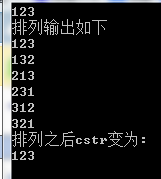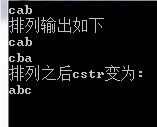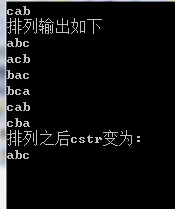固然我们可以自己使用递归编写全排列程序,但是既然STL里面已将有了这个功能为什么不直接用呢,下面就写一下直接使用C++ STL生成全排序的程序
函数名:next_permutation
包含头文件:algorithm
函数原型:
template<class BidirectionalIterator>
bool next_permutation(BidirectionalIterator _First, BidirectionalIterator _Last );
template<class BidirectionalIterator, class BinaryPredicate>
bool next_permutation(BidirectionalIterator _First, BidirectionalIterator _Last, BinaryPredicate _Comp );
两个重载函数,第二个带谓词参数_Comp,其中只带两个参数的版本,默认谓词函数为"小于".
返回值:bool类型(默认若当前调用排列到达最大字典序则返回false,同时重新设置该排列为最小字典序,否则返回true,并按照字典递增的顺序输出下一个排列。例如,在字母表中,abcd的下一单词排列为abdc)
所以如果是生成一个数组的全排列,先要对数组按升序排序,然后使用do-while语句循环调用next_permutation函数
1 #include<iostream> 2 #include<algorithm> 3 #include<string> 4 using namespace std; 5 int main() 6 { 7 string str; 8 cin>>str; 9 int len=str.length(); 10 char *cstr=(char *)str.c_str(); 11 cout<<"排列输出如下"<<endl; 12 do 13 { 14 cout<<cstr<<endl; 15 }while(next_permutation(cstr,cstr+len)); 16 cout<<"排列之后cstr变为:"<<endl; 17 cout<<cstr; 18 return 0; 19 }
上面是一个没有加排序直接调用nextpermation看一下,不同输入的情况下输出结果的比较


1 #include<iostream> 2 #include<algorithm> 3 #include<string> 4 using namespace std; 5 int main() 6 { 7 string str; 8 cin>>str; 9 int len=str.length(); 10 char *cstr=(char *)str.c_str(); 11 sort(cstr,cstr+len); 12 cout<<"排列输出如下"<<endl; 13 do 14 { 15 cout<<cstr<<endl; 16 }while(next_permutation(cstr,cstr+len)); 17 cout<<"排列之后cstr变为:"<<endl; 18 cout<<cstr; 19 return 0; 20 }
加上排序之后,看看效果